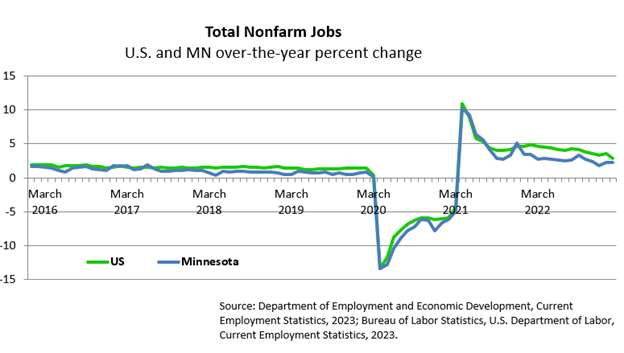by Nick Dobbins
April 2023
The Minneapolis-St. Paul-Bloomington MSA lost 8,454 jobs or 0.4% over the month in March on an unadjusted basis. It was the worst over-the-month growth of any MSA in Minnesota, tied with Grand Forks, and slightly behind the statewide growth of -0.3%. The largest real losses came in Professional and Business Services, which was off 3,314 jobs (1.1%), with declines in all published component sectors. The largest proportional decline was in Mining, Logging, and Construction (down 1.6% or 1,214 jobs). Government employers lost 2,155 jobs (0.9%) with losses at all three levels.
Over the year the metro area added 34,877 jobs or 1.8%. Leisure and Hospitality was up 16,441 (10.2%). The next-highest supersector in both real and proportional growth was Health Care and Social Assistance, which was up 11,506 jobs or 3.4%. Manufacturers added 4,836 jobs, or 2.4%, with growth in both Durable and Non-Durable Goods Manufacturing. Two of 10 published supersectors added jobs on the year, as Information was up 0.7% (203 jobs), and Educational and Health Services was up 0.2% (603 jobs). Just three of 10 published supersectors posted negative annual growth, but all were off by more than 1%. Mining, Logging, and Construction was down 3.7%, Financial Activities was down 1.5%, and Professional and Business Services was down 1.3%, with component Employment Services off 8.3%.
Employers in the Duluth-Superior MSA lost 323 jobs or 0.2% in March. Seven of the 10 published supersectors posted monthly losses, with the largest real and proportional decline coming in Mining, Logging, and Construction which was down 1.9% or 174 jobs. Every other decline was less than 1% and fewer than 100 jobs. The three supersectors with positive monthly growth were Manufacturing, Educational and Health Services, and Leisure and Hospitality, although none posted especially large gains.
Over the year the Duluth-Superior MSA added 2,056 jobs or 1.6%. It was the lowest over-the-year growth of any MSA in the state. Trade, Transportation, and Utilities drove the growth, adding 1,009 jobs (4.3%), caused in large part by the addition of 858 jobs (6.1%) in Retail Trade. Other Services added 224 jobs (4%), and Leisure and Hospitality added 389 (3%). Government employers had the largest real job losses, off by 212 jobs or 0.8%.
Rochester area employment was up by 266 (0.2%) in March. The addition of 189 jobs (0.4%) in Educational and Health Services and 87 jobs (0.7%) in Government employment helped keep employment growth in the area in the positive. Five of 10 published supersectors lost jobs, with Manufacturing off by 41 (0.4%) and Other Services off by 22 (0.6%).
Over the year Rochester added 4,014 jobs (3.4%). Mining, Logging, and Construction had the largest proportional growth, up 6.6% (290 jobs), while the largest real job growth came in Educational and Health Services, which was up 1,510 (2.9%). Trade, Transportation, and Utilities added 915 jobs (5.5%) thanks to the addition of 927 jobs (7.9%) in component Retail Trade. Information was the only supersector to lose jobs on the year, off by 41 (3.7%).
The St. Cloud MSA added 147 jobs (0.1%) over the month of March. Trade, Transportation, and Utilities added 175 jobs (0.8%), with most of that growth coming in Retail Trade (up 163 or 1.3%). Educational and Health Services added 106 jobs (0.5%), and Manufacturing added 66 (0.4%). The largest real and proportional job loss came in Government, which was off by 153 jobs or 1% with declines at all three levels of government.
Over the year the St. Cloud area added 3,287 jobs (3.2%). Mining, Logging, and Construction added 740 jobs (11.9%), Educational and Health Services added 807 jobs (3.8%), Leisure and Hospitality added 496 jobs (6.6%), and Manufacturing added 781 jobs (5.3%). Three supersectors posted negative growth, with the largest real and proportional declines coming in Professional and Business Services, which was off by 354 jobs or 4.5%.
Employment in the Mankato-North Mankato MSA was up 0.7% (409 jobs) in March. This was the highest proportional monthly growth of any MSA in the state. Service providers added 327 jobs (0.7%), and goods producers added 82 (0.8%).
Over the year Mankato-North Mankato area employment was up 4.3% (2,395 jobs), the best annual proportional growth of any MSA in Minnesota. Private sector employment was up 4.4% (2,025 jobs), while public sector employment was up 3.8% (370 jobs).
The Fargo-Moorhead MSA added 196 jobs (0.1%) over the month in March. Leisure and Hospitality drove the growth, adding 537 jobs or 3.7%, the largest real and proportional growth of any supersector in the area, followed by Mining, Logging, and Construction which added 175 jobs (or 2%). The biggest declines came in Professional, Business, and Technical Services which lost 221 jobs or 1.5%.
On an annual basis employment in Fargo-Moorhead was up 4,166 (2.9%). Mining, Logging, and Construction was up 12.3% (961 jobs), and Leisure and Hospitality was up 9.8% (1,334 jobs). Just three supersectors posted negative growth in the area, led by Information which shed 251 jobs (or 8.7%).
Employment in Grand Forks-East Grand Forks was down 0.4% (197 jobs) in March, tying it with Minneapolis-St. Paul for the lowest proportional growth of any MSA in the state. Losses in Government drove the decline as public sector employers shed 290 jobs (2.2%), with negative growth at every level of government. The highest proportional growth was in Mining, Logging, and Construction, where employment was up 2.7% (72 jobs).
Over the year the Grand Forks-East Grand Forks MSA added 1,580 jobs (3%). All of the 10 published supersectors posted positive annual growth. Manufacturing was up 247 jobs (6.1%), and Trade, Transportation, and Utilities was up 513 jobs (5%), primarily because of the addition of 427 jobs (6.5%) in Retail Trade.
